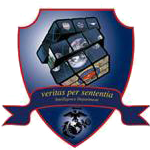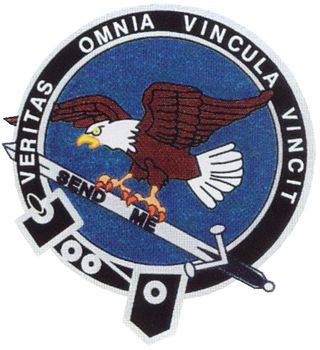Related Research Articles

The Defense Intelligence Agency (DIA) is an intelligence agency and combat support agency of the United States Department of Defense, specializing in defense and military intelligence.

Human intelligence is intelligence-gathering by means of human sources and interpersonal communication. It is distinct from more technical intelligence-gathering disciplines, such as signals intelligence (SIGINT), imagery intelligence (IMINT), and measurement and signature intelligence (MASINT). HUMINT can be conducted in a variety of ways, including via espionage, reconnaissance, interrogation, witness interviews, or torture. Although associated with military and intelligence agencies, HUMINT can also apply in various civilian sectors such as law enforcement.

Counterintelligence (counter-intelligence) or counterespionage (counter-espionage) is any activity aimed at protecting an agency's intelligence program from an opposition's intelligence service. It includes gathering information and conducting activities to prevent espionage, sabotage, assassinations or other intelligence activities conducted by, for, or on behalf of foreign powers, organizations or persons.

Defence Intelligence (DI) is an organisation within the United Kingdom intelligence community which focuses on gathering and analysing military intelligence. It differs from the UK's intelligence agencies in that it is an integral part of a government department – the Ministry of Defence (MoD) – rather than a stand-alone organisation. The organisation employs a mixture of civilian and military staff and is funded within the UK's defence budget. The organisation was formerly known as the Defence Intelligence Staff (DIS), but changed its name in 2009.
An intelligence officer is a person employed by an organization to collect, compile or analyze information which is of use to that organization. The word of officer is a working title, not a rank, used in the same way a "police officer" can also be a sergeant, or in the military, in which non-commissioned personnel may serve as intelligence officers.

The Directorate of Operations (DO), less formally called the Clandestine Service, is a component of the US Central Intelligence Agency. It was known as the Directorate of Plans from 1951 to 1973; as the Directorate of Operations from 1973 to 2005; and as the National Clandestine Service (NCS) from 2005 to 2015.

The 519th Military Intelligence Battalion is a unit of the United States Army.

The Marine Corps Intelligence is the intelligence arm of the United States Marine Corps (USMC) and an element of the United States Intelligence Community. The Director of Intelligence supervises the Intelligence Department of HQMC and is responsible for policy, plans, programming, budgets, and staff supervision of Intelligence and supporting activities within the U.S. Marine Corps as well as supervising the Marine Corps Intelligence Activity (MCIA). The department supports the Commandant of the Marine Corps (CMC) in his role as a member of the Joint Chiefs of Staff (JCS), represents the service in Joint and Intelligence Community matters, and exercises supervision over the MCIA.

The United States Army Intelligence Support Activity (USAISA), frequently shortened to Intelligence Support Activity (ISA), also known at various times as Mission Support Activity (MSA), Office of Military Support (OMS), Field Operations Group (FOG), Studies and Analysis Activity (SAA), Tactical Concept Activity, Tactical Support Team, and Tactical Coordination Detachment, and also nicknamed "The Activity" and the Army of Northern Virginia, is a United States Army Special Operations unit which serves as the intelligence gathering component of Joint Special Operations Command (JSOC). Within JSOC, the unit is often referred to as Task Force Orange. Originally subordinated to the US Army Intelligence and Security Command (INSCOM), it is one of the least known intelligence components of the United States military, tasked with clandestine HUMINT operations and collecting actionable intelligence during or prior to JSOC missions.
Intelligence collection management is the process of managing and organizing the collection of intelligence from various sources. The collection department of an intelligence organization may attempt basic validation of what it collects, but is not supposed to analyze its significance. There is debate in U.S. intelligence community on the difference between validation and analysis, where the National Security Agency may try to interpret information when such interpretation is the job of another agency.
Intelligence cycle management refers to the overall activity of guiding the intelligence cycle, which is a set of processes used to provide decision-useful information (intelligence) to leaders. The cycle consists of several processes, including planning and direction, collection, processing and exploitation, analysis and production, and dissemination and integration. The related field of counterintelligence is tasked with impeding the intelligence efforts of others. Intelligence organizations are not infallible but, when properly managed and tasked, can be among the most valuable tools of management and government.
National intelligence programs, and, by extension, the overall defenses of nations, are vulnerable to attack. It is the role of intelligence cycle security to protect the process embodied in the intelligence cycle, and that which it defends. A number of disciplines go into protecting the intelligence cycle. One of the challenges is there are a wide range of potential threats, so threat assessment, if complete, is a complex task. Governments try to protect three things:

Special reconnaissance (SR) is conducted by small units, such as a recon team, made up of highly trained military personnel, usually from special forces units and/or military intelligence organizations. Special reconnaissance teams operate behind enemy lines, avoiding direct combat and detection by the enemy. As a role, SR is distinct from commando operations, but both are often carried out by the same units. The SR role frequently includes covert direction of airstrikes and indirect fire, in areas deep behind enemy lines, placement of remotely monitored sensors, and preparations for other special forces. Like other special forces, SR units may also carry out direct action and unconventional warfare, including guerrilla operations.
The reconnaissance mission within the United States Marine Corps is divided into two distinct but complementary aspects; Marine Division Recon and Force Reconnaissance.
The Central Intelligence Agency (CIA), a United States intelligence agency that "provides objective intelligence on foreign countries", also informally referred to as the Agency. The CIA is part of the United States Intelligence Community, is organized into numerus divisions. The divisions include directors, deputy directors, and offices. The CIA board is made up of five distinct entitles called Directorates. The CIA is overseen by the Director of Central Intelligence. Under the Director of Central Intelligence is the Deputy Director of Central Intelligence. Under this the CIA is divided into four directorates. These directorates are as follows:
The Army Geospatial Center (AGC) is a Major Subordinate Command of the United States Army Corps of Engineers. It is located in Alexandria, Virginia, within the Humphreys Engineering Center adjacent to the Fort Belvoir military reservation.

Target analysis is an examination of potential targets to determine military importance, priority of attack, and weapons required to obtain a desired level of damage or casualties. The Central Intelligence Agency defines it as, "network analysis techniques and specialized analytical tools to identify and detail key figures and organizations who may pose a threat to US interests."

United States Army Counterintelligence (ACI) is the component of United States Army Military Intelligence which conducts counterintelligence activities to detect, identify, assess, counter, exploit and/or neutralize adversarial, foreign intelligence services, international terrorist organizations, and insider threats to the United States Army and U.S. Department of Defense (DoD).

The 525th Expeditionary Military Intelligence Brigade (Expeditionary) is a unit of the United States Army specializing in the acquisition and analysis of information with potential military value. On 28 October 2014, the unit was reflagged from the "525th Battlefield Surveillance Brigade" to an expeditionary military intelligence brigade, the first of its kind.
References
- 1 2 3 4 "Tactical HUMINT Battalion". Fas.org. Retrieved 2015-05-07.
- ↑ "Counterintelligence/Human Intelligence Exploitation Team (HET) Operations in Iraq" (PDF). Info.publicintelligence.net. Retrieved 2015-05-07.
- ↑ "The Pentagon's Spies". Nsarchive.gwu.edu. Retrieved 2015-05-07.
- 1 2 3 "FM 2-22.3 Chapter 2 — HUMAN INTELLIGENCE STRUCTURE". Rdl.train.army.mil. Archived from the original on 2016-03-04. Retrieved 2015-05-07.
- 1 2 "Humint-Centric Operations : Developing Actionable Intelligence in the Urban Counterinsurgency Environment" (PDF). Au.af.mil. Archived from the original (PDF) on December 28, 2010. Retrieved 2015-05-07.
- 1 2 "Human Intelligence: Past, Present, And Future | Simon Sundaraj-Keun". Simonsundarajkeun.wordpress.com. Retrieved 2015-05-07.
- ↑ "Stabilizing Iraq: - Intelligence Lessons for Afghanistan - The Washington Institute for Near East Policy". Washingtoninstitute.org. 2009-05-28. Retrieved 2015-05-07.